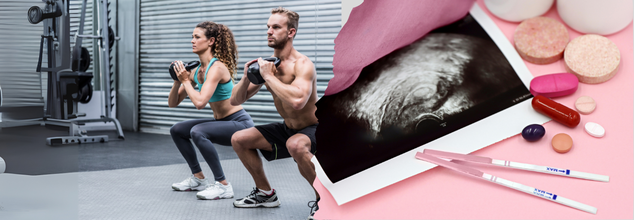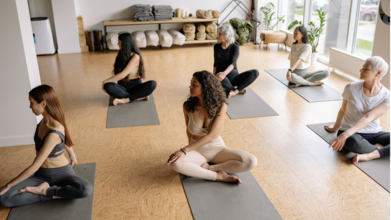- Health Conditions A-Z
- Health & Wellness
- Nutrition
- Fitness
- Health News
- Ayurveda
- Videos
- Medicine A-Z
- Parenting
- Web Stories
Can Exercising Too Much Affect Fertility And Delay Pregnancy?

Credits: Canva
Exercise is universally recognized as a cornerstone of physical and mental well-being. It strengthens the heart, enhances brain function, supports metabolism, and plays a key role in managing stress. But when it comes to fertility, especially for couples trying to conceive, there’s a delicate balance. While moderate exercise can significantly improve the chances of conception, overtraining or pushing the body into an energy deficit may do just the opposite.
According to recent data, moderate physical activity improves fertility by up to 27% in women and can lead to a 44% increase in total sperm count in men. But, as with most things in health, more isn’t always better.
How Moderate Exercise Enhances Fertility?
For those trying to conceive, physical activity is a potent ally. “Exercise is not just about being fit—it's a powerful solution for reproductive health,” says Dr. Nishi Singh, IVF specialist. “Moderate, regular exercise can truly be a life-changer for those struggling to conceive.” Here’s how moderate movement helps reproductive function:
Hormonal Harmony: Exercise plays a critical role in balancing hormones like estrogen, progesterone, and testosterone—all essential for fertility.
Healthy Weight Maintenance: Maintaining a healthy BMI helps reduce obesity-related fertility complications, such as insulin resistance and anovulation.
Improved Ovulation & Egg Quality: Enhanced blood flow to the ovaries improves the quality of the eggs and increases the chances of implantation.
Boosted Sperm Health: In men, strength training and regular cardio are associated with better sperm concentration and motility.
Reduced Stress: Physical activity releases endorphins, lowering stress—a known inhibitor of ovulation and libido.
What Counts as “Moderate” Exercise?
Moderate activity includes any movement that raises your heart rate, increases your breathing, and warms up your body—without pushing you to exhaustion. Think:
- Brisk walking
- Cycling on flat terrain
- Light jogging
- Swimming
- Low-impact aerobics
“You should still be able to talk but not sing,” explains Dr. Singh, outlining how to self-assess moderate intensity. These activities encourage cardiovascular health, balance hormones, and reduce cortisol (the stress hormone), all of which can improve fertility outcomes.
When Exercise Becomes Too Much of a Good Thing?
While movement is often seen as medicine, excessive exercise—particularly when not paired with proper nutrition—can lead to an energy deficit. This occurs when the body doesn’t receive enough fuel to sustain its essential functions, including reproduction. In women, this imbalance can result in irregular or missed menstrual cycles, disrupted ovulation, lower estrogen levels, and diminished egg quality. For men, overtraining may suppress testosterone production and lead to a reduced sperm count, ultimately affecting fertility potential.
“The reproductive system is highly sensitive to energy deficit,” says Dr. Singh. “When the body doesn’t have enough fuel, it prioritizes survival systems like the heart and brain over reproduction.”
How Underweight or Overweight Status Affects Fertility?
Body weight is another critical aspect linked to fertility. A BMI below 18.5 (underweight) or within the obese range can trigger ovulatory disorders, hormonal imbalance, and menstrual irregularities.
Even when ovulation seems regular, issues like insulin resistance, thyroid dysfunction, and polycystic ovarian syndrome (PCOS)—often tied to weight extremes—can hinder conception. Regular moderate exercise supports optimal weight, insulin sensitivity, and thyroid health.
List of Fertility-Friendly Workouts
Dr. Singh emphasizes the importance of a balanced fitness plan that supports the body’s reproductive goals:
Cardio: Walking, swimming, or light jogging to build endurance and improve circulation.
Strength Training: Helps prepare the body for pregnancy by building muscular support for the core and lower body.
Mind-Body Workouts: Yoga and Pilates reduce stress, improve flexibility, and support hormonal balance, creating an ideal environment for conception.
“If you’re unsure how much exercise is right for you, consult a fertility specialist or trainer familiar with pre-conception fitness,” she advises.
Every body is different—and so is every fertility journey. What works for one couple may not be ideal for another. The key lies in listening to your body and monitoring symptoms.
Here are some red flags that your exercise regimen may be negatively impacting fertility:
- Missed or irregular periods
- Low libido
- Constant fatigue or overtraining injuries
- Plateauing or regressing physical performance
In these cases, cutting back on intensity, increasing caloric intake, or taking rest days may help restore hormonal balance.
Exercise can be an incredible fertility booster—when done in moderation. It helps regulate hormones, improves reproductive organ function, boosts egg and sperm health, and reduces stress. However, overdoing it can tip the scales in the wrong direction, potentially delaying conception.
As Dr. Singh puts it, “Effective exercise is not about pushing harder—it’s about working smarter. A moderate, sustainable fitness plan not only supports overall wellness but creates the best possible environment for a healthy pregnancy.”
If you’re actively trying to conceive, consider syncing your fitness goals with your fertility goals. Whether that means dialing it back or adding gentle movement to your day, the right approach can make all the difference.
A Simple 10-Minute Daily Habit Can Boost Sleep Quality

Credits: Canva
Public health advice has usually centered on how much sleep we get. Eight hours has long been the magic number, but researchers are now uncovering that how well you sleep matters just as much — maybe even more. Deep, restorative sleep is the body’s prime time for repairing tissue, consolidating memories, and balancing mood-regulating hormones. And as it turns out, a surprisingly simple daily habit can help you get more of it.
A new study from The University of Texas at Austin, published in the Journal of Physical Activity & Health, followed students over several months using wearable devices like Fitbits. Instead of just counting total exercise minutes, the research team zoomed in on how often people moved.
The big reveal? Those who exercised regularly even for just 10 minutes a day enjoyed deeper, more restorative non-REM sleep, the stage most critical for brain and body recovery. “Frequency does seem to matter,” said Benjamin Baird, a research assistant professor of psychology and one of the study’s lead authors.
Why 10 Minutes Is Enough?
Moderate to vigorous activity — think brisk walking, cycling, or any movement that quickens your breath while still allowing conversation — for as little as 10 minutes daily had measurable benefits. This wasn’t about logging intense workouts or breaking personal records. Even light, consistent movement like short walks or standing breaks improved sleep quality and next-day mood.
According to Chris Corral, co-lead of the study, “You don’t need to run marathons. Just moving a little each day helps. Light activity counts too. Doing something is better than doing nothing.”
Participants who moved daily didn’t just sleep better — they woke up feeling more energized and reported lower stress levels. This connection between non-REM sleep and mood has been observed before, but most earlier studies only looked at short-term effects in controlled lab settings.
What made this study different was its real-world design. By tracking people’s habits continuously for months, researchers could see the cumulative benefits of consistent movement on sleep and emotional well-being.
How We Measure “Enough” Exercise?
Current guidelines from the Centers for Disease Control and Prevention (CDC) and World Health Organization (WHO) recommend 150 minutes of moderate activity per week. But they don’t specify how to spread it out. That gap matters.
“If you pack all that activity into the weekend, you might miss out on the sleep benefits of moving daily,” Corral explained. The UT findings hint that public health advice may need updating — shifting the focus from total minutes to frequency.
How Sleep Quality Shapes Overall Health?
Deep sleep isn’t just about feeling rested. It’s when the brain clears waste proteins linked to neurodegenerative diseases like Alzheimer’s. It’s also when muscles repair, immune cells strengthen, and the nervous system resets. Poor-quality sleep, on the other hand, is tied to higher risks of heart disease, diabetes, depression, and even shortened lifespan.
In other words, this isn’t just about feeling less groggy — it’s about long-term brain and body health.
The study’s use of wearable trackers like Fitbits allowed researchers to capture a detailed picture of both movement and sleep in real life — not just in the artificial environment of a lab. This is part of the Whole Communities—Whole Health initiative, an interdisciplinary project aiming to understand how everyday habits affect overall well-being.
Next, researchers plan to see if these findings hold true in more diverse populations, including older adults and people with chronic health conditions.
Why Better Sleep Is Essential for Everyday Wellness?
Move daily, even briefly — A brisk walk after dinner, stretching breaks at your desk, or climbing stairs instead of taking the elevator all count.
Consistency beats intensity — Doing a little bit every day trumps exhausting yourself a few times a week.
Pair movement with good sleep hygiene — Keep a consistent bedtime, limit screen exposure before bed, and create a cool, dark sleeping environment for maximum benefit.
Better sleep doesn’t require an overhaul of your schedule or a gym membership. Just 10 minutes of daily movement can make a tangible difference in how deeply and restoratively you sleep.
Sleep is the foundation for energy, focus, emotional resilience, and long-term health. And unlike expensive treatments or complicated regimens, this fix is free, simple, and accessible to almost everyone.
As Baird put it, “Current guidelines don’t reflect the importance of frequency for sleep health. Having this kind of data allows us to start thinking about whether they should.” So if you want to sleep deeper, feel sharper, and start your days with more energy, the solution might be as simple as lacing up your shoes and moving every single day.
Landon Dickerson Suffers From A Right Leg Injury: What Are The Common Football Injuries And How Can You Prevent It?

Credits: Wikimedia Commons
The Philadelphia Eagles’ Pro Bowl left guard Landon Dickerson was helped off the field and later carted inside after suffering an apparent right leg injury during the team’s open practice Sunday night at Lincoln Financial Field.
The incident happened late in the more than two-hour practice during a pass play, when quarterback Jalen Hurts connected with running back Saquon Barkley on the opposite side of the field. Dickerson went down and stayed on the ground for several minutes, surrounded by teammates as a hush fell over the crowd of nearly 50,000 fans.
Also Read: 3 Common Yoga Mistakes That Could Be Limiting Your Progress
Unable to put much weight on his right leg, Dickerson was assisted off before riding a cart indoors. He was replaced in the lineup by Brett Toth.
The injury comes a day after Dickerson appeared on the team’s injury report with a knee issue, which limited his participation in practice on Saturday. He was not listed on the report for Sunday.
What Are The Common Injuries in Football?
Football players are more likely to get hurt during matches than during training, with risks coming from tackling, sprinting, twisting, jumping, or even repeating the same movements until fatigue sets in. Collisions, poor conditioning, or re-injuring a previously weakened area can also contribute.
Sprained Ankle
Quick changes of direction and uneven surfaces make ankle sprains one of the most common football injuries. This happens when the ankle rolls inward or outward, overstretching the ligaments.
Management: Follow the POLICE principles: Protect, Optimal loading, Ice, Compression, Elevation, and avoid HARM factors: Heat, Alcohol, Running, Massage, in the first three days.
Hamstring Strain
Hamstring muscles power a player’s acceleration. Sudden bursts of speed without adequate flexibility or strength can cause a strain.
Management: Use POLICE and HARM steps. Prevention includes stretching, foam rolling, and strengthening exercises like deadlifts, leg curls, and bridges.
Groin Strain
Twisting, kicking, or rapid directional changes can strain the inner thigh muscles, also known as adductors.
Management: Same POLICE and HARM, with prevention through regular stretching and strengthening exercises such as side lunges and adductor side bridges.
ACL Injury
The anterior cruciate ligament is critical for knee stability. Injuries often occur when the lower leg stays planted while the upper leg twists, during tackles, or awkward landings.
Management: Mild sprains may heal with physiotherapy, but severe tears often require surgery. Persistent swelling or pain should be checked by a professional.
Preventing Football Injuries
- Strengthen lower limbs with exercises like squats, lunges, and calf raises.
- Warm up with dynamic stretches and sport-specific drills.
- Cool down after matches to aid recovery.
- Wear proper gear, including fitted boots and shin guards.
- Stay hydrated, eat well, and rest between games.
3 Common Yoga Mistakes That Could Be Limiting Your Progress

Yoga, at its heart, is a journey of balance, patience, and self-awareness. Yet, even regular practitioners can unknowingly fall into habits that limit progress or compromise the essence of the practice. Celebrity nutritionist Rujuta Diwekar, who works with stars like Kareena Kapoor, Alia Bhatt, Varun Dhawan, Saif Ali Khan and Karisma Kapoor, recently shared three common yoga mistakes that many of us make and how to correct them. Her advice is simple, practical, and rooted in tradition.
1. Always Starting With the Right Side
The first, she says, is starting every asana from the right side. “Because what happens is that we stay on the right side for a long time and on the left side for a short time. And because of that, the weakness of the left side remains. And the overall imbalance in the body also remains.”This habit, she explains, can unconsciously deepen the existing imbalances in the body. Yoga, after all, is a practice of samatva or balance. The aim is not to favour one side but to restore equilibrium—physically, mentally, and emotionally.
She suggests a simple correction. Yoga should be done with awareness. She says how even sitting postures like Sukhasana should be alternated to ensure both sides of the body are equally engaged. Start from the weaker or underused side. It may feel awkward initially, but over time, it helps realign the body and build balanced strength.
2. Only Practising the Asanas You Are Good At
Rujuta points to the second mistake: “The asanas that we like or that we know well, we practise those asanas again and again. So the ones that we do not know, we do not even reach the lanes of those asanas.”This is a common pitfall. We gravitate towards what feels familiar and comfortable. But yoga is not meant to keep us within our limits; it is meant to gently stretch them. She encourages practitioners to explore the lesser-known asanas, especially those we tend to avoid, like backbends or twists. “We should go to their lanes, we should practise them, and we should have patience with ourselves. Little by little, every asana, especially backbends, will also come.”
She reminds us, “Yoga is not for show-offs. Yoga is for strength. For inner strength. This practice is not for outsiders.” It is a deeply personal journey, and real growth lies in consistency and courage, not perfection.
3. Skipping Practice When Time Is Short
The third and perhaps most relatable mistake is an all-or-nothing mindset. “If we do not have all the time, then we do not practise any asana at all,” Rujuta points out.But this is not how yoga works. “If you do not have time for 12 Surya Namaskars, then do 6. If you do not have time for 6, then do 3. But do it.” Even five minutes of mindful movement can bring enormous benefits. Over time, it is the commitment, not the duration, that matters most.
She also urges balance between the physical and the subtle. “If you are doing pranayama only every day, then do asanas also. If you are doing asanas only every day, then do pranayama once a month.” Her advice is to explore and embrace all aspects of yoga. That way, even if your routine is limited, it is never lopsided.
Yoga is not about being perfect in every pose. It is about showing up. “In your asana practice, explore the key aspects of yoga a little bit,” says Rujuta. “And give this gift of yoga to yourself in your lifetime.”
Whether you are a beginner or a seasoned yogi, her words are a gentle but firm nudge back to the basics. Do not let routine, comfort, or lack of time come in the way of your practice. As she sums up beautifully, yoga is a gift and one worth giving yourself every single day.
© 2024 Bennett, Coleman & Company Limited

